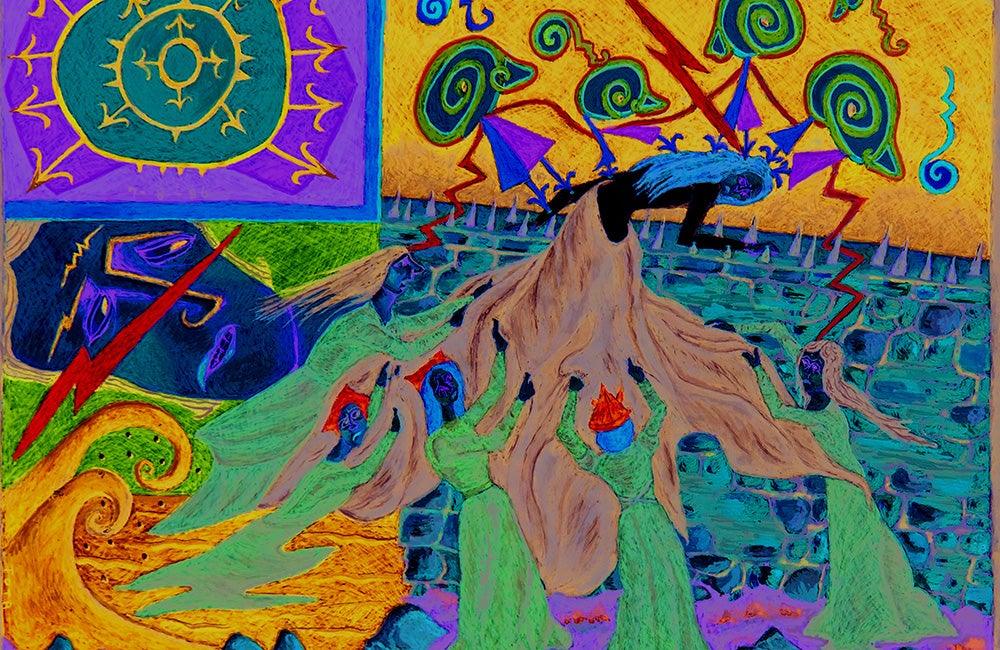First published: Summer 2018
Josephine Tota (1910–1996) was a seamstress and amateur artist who lived a conventional life among the Italian immigrant community in Rochester, New York. In her seventies, she spent countless hours painting in the privacy of her home, where she imbued over 90 small jewel-like paintings with the richness of her strange imagination. Despite the appeal of her bright, prismatic palette, unsettling narratives hopscotch around shifting spaces. Tota’s visions capture and condense anxieties accumulated over a lifetime. It is this powerful body of work – dozens of untamed paintings in egg tempera and gilding on board, completed at the end of her life – that the exhibition “The Surreal Visions of Josephine Tota” explores and advocates for inclusion into the canon of self-taught, visionary art.
Tota depicted her small-scale, encoded domestic dramas with an intrepid and intellectually playful approach to image making. Her images sprang from a deep well of memories and dreams. Themes of metamorphosis, family bonds, physical pain, human frailty, the natural world, loss and tragedy dominate her obsessive and otherworldly depictions. Their compact size encourages intimate viewing: the smallest is about 5 by 1.5 inches; the largest is 10 by 32 inches. These works were made for an audience of one: Tota.
Her unsettling, female-led narratives are rife with women subjugated by the circumstances of life or empowered with mystical and unknowable forces. Her most common motifs include anxious women, human/plant hybrids, the third eye, masks, tears of blood, clothing, and needles and threads. Eyes, a powerful source of Tota’s magic, were a source of profound anxiety for her as well. Due to her visual nature and the threat she experienced from cataract surgery during the height of her productive period, her omnipresent eyes – glaring, seeking, weeping blood – are laden with psychological weight.
Images like these, not words, were the language in which Tota communicated. No papers or letters exist, and our knowledge of her life comes primarily from the personal accounts of family members. The reward for the persistent and curious viewer of Tota’s paintings is an engagement with work that unfolds over time in labyrinthine tangles of both art-historical and personal references.

Untitled, 1983, egg tempera on panel, 8 x 7 ins. / 20.3 x 17.8 cm, courtesy: Rosamond Tota
Born in Corato, Italy, in 1910, Tota felt a deep and abiding connection with the spirituality and mystery of the natural world. As a deeply sensitive and unusually bright and outspoken child, Tota often felt alienated from her family. Her feelings of isolation and marginalisation were reinforced by the circumstances of her life, including early experiences of childhood poverty and the trauma of immigrating to the United States at the age of ten. Similar to many immigrant women who have struggled with the displacement and duality of living between their home and adopted cultures, Tota often described feeling “torn” or fractured; in her paintings destabilised, unravelling identities take shape as women with multiple heads that grow from a single body.
Tota faced and survived many challenges throughout her life, and art provided her solace. When her husband passed away and she retired from work as a seamstress in her sixties, she began to take amateur painting and ceramics classes at the Memorial Art Gallery’s community art school. After painting in a representational style like that of her instructors, Tota was inspired to try egg tempera after visiting the medieval and early Italian Renaissance galleries at the Metropolitan Museum of Art. An artist friend taught her the obsessive, meticulous technique, one that complemented her creative temperament. She quickly turned from traditional landscapes and still lifes to intensely insular images teeming with figures, plants, enigmatic action, and ambiguous settings. In both subject and style, these paintings had no precedent in her previous work.
This is an article extract; read the full article in Raw Vision #98




